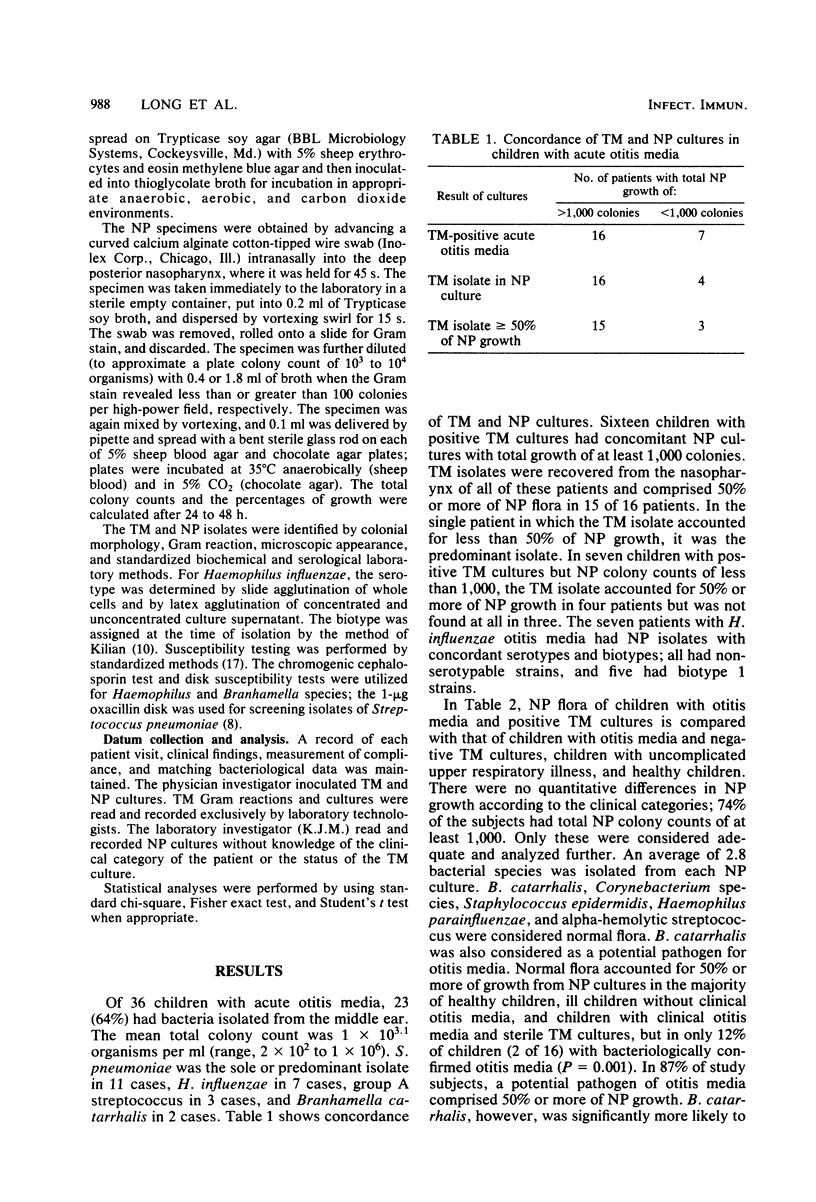Abstract
A semiquantitative nasopharyngeal culture was found to be sensitive and specific in predicting middle ear pathogens in children with acute bacterial otitis media. In nasopharyngeal specimens with growth of at least 1,000 colonies, the tympanocentesis isolate was present and was either the predominant isolate or accounted for 50% of growth in 16 of 16 children. Data suggest that virulence of nasopharyngeal organisms plays a role in the pathogenesis of acute otitis media. Qualitative differences were found in the nasopharyngeal flora of children with bacterial otitis media as compared with children with clinical otitis media and sterile tympanocentesis cultures, children with uncomplicated upper respiratory illness, and healthy children. Abundant growth of Haemophilus influenzae (greater than or equal to 50% total colony count) was associated with children with bacterial otitis media, and abundant Branhamella catarrhalis was associated with the others (P less than or equal to 0.01). Abundant growth of Streptococcus pneumoniae occurred frequently and regardless of clinical category. Antibiotic treatment of children with otitis media resulted in rapid quantitative and qualitative changes in nasopharyngeal flora.
Full text
PDF




Selected References
These references are in PubMed. This may not be the complete list of references from this article.
- Bodor F. F. Conjunctivitis-otitis syndrome. Pediatrics. 1982 Jun;69(6):695–698. [PubMed] [Google Scholar]
- Brook I., Finegold S. M. Bacteriology of chronic otitis media. JAMA. 1979 Feb 2;241(5):487–488. [PubMed] [Google Scholar]
- Feingold M., Klein J. O., Haslam G. E., Jr, Finland M., Gellis S. S., Tilles J. G. Acute otitis media in children. Bacteriological findings in middle ear fluid obtained by needle aspiration. Am J Dis Child. 1966 Apr;111(4):361–365. doi: 10.1001/archpedi.1966.02090070059005. [DOI] [PubMed] [Google Scholar]
- Gray B. M., Converse G. M., 3rd, Dillon H. C., Jr Epidemiologic studies of Streptococcus pneumoniae in infants: acquisition, carriage, and infection during the first 24 months of life. J Infect Dis. 1980 Dec;142(6):923–933. doi: 10.1093/infdis/142.6.923. [DOI] [PubMed] [Google Scholar]
- Groothuis J. R., Sell S. H., Wright P. F., Thompson J. M., Altemeier W. A., 3rd Otitis media in infancy: tympanometric findings. Pediatrics. 1979 Mar;63(3):435–442. [PubMed] [Google Scholar]
- Henderson F. W., Collier A. M., Sanyal M. A., Watkins J. M., Fairclough D. L., Clyde W. A., Jr, Denny F. W. A longitudinal study of respiratory viruses and bacteria in the etiology of acute otitis media with effusion. N Engl J Med. 1982 Jun 10;306(23):1377–1383. doi: 10.1056/NEJM198206103062301. [DOI] [PubMed] [Google Scholar]
- Hendley J. O., Sande M. A., Stewart P. M., Gwaltney J. M., Jr Spread of Streptococcus pneumoniae in families. I. Carriage rates and distribution of types. J Infect Dis. 1975 Jul;132(1):55–61. doi: 10.1093/infdis/132.1.55. [DOI] [PubMed] [Google Scholar]
- Kilian M. A taxonomic study of the genus Haemophilus, with the proposal of a new species. J Gen Microbiol. 1976 Mar;93(1):9–62. doi: 10.1099/00221287-93-1-9. [DOI] [PubMed] [Google Scholar]
- Klein B. S., Dollete F. R., Yolken R. H. The role of respiratory syncytial virus and other viral pathogens in acute otitis media. J Pediatr. 1982 Jul;101(1):16–20. doi: 10.1016/s0022-3476(82)80172-8. [DOI] [PubMed] [Google Scholar]
- Lampe R. M., Mason E. O., Jr, Kaplan S. L., Umstead C. L., Yow M. D., Feigin R. D. Adherence of Haemophilus influenzae to buccal epithelial cells. Infect Immun. 1982 Jan;35(1):166–172. doi: 10.1128/iai.35.1.166-172.1982. [DOI] [PMC free article] [PubMed] [Google Scholar]
- Loda F. A., Collier A. M., Glezen W. P., Strangert K., Clyde W. A., Jr, Denny F. W. Occurrence of Diplococcus pneumoniae in the upper respiratory tract of children. J Pediatr. 1975 Dec;87(6 Pt 2):1087–1093. doi: 10.1016/s0022-3476(75)80120-x. [DOI] [PubMed] [Google Scholar]
- Long S. S., Teter M. J., Gilligan P. H. Biotype of Haemophilus influenzae: correlation with virulence and ampicillin resistance. J Infect Dis. 1983 May;147(5):800–806. doi: 10.1093/infdis/147.5.800. [DOI] [PubMed] [Google Scholar]
- Sanyal M. A., Henderson F. W., Stempel E. C., Collier A. M., Denny F. W. Effect of upper respiratory tract infection on eustachian tube ventilatory function in the preschool child. J Pediatr. 1980 Jul;97(1):11–15. doi: 10.1016/s0022-3476(80)80121-1. [DOI] [PubMed] [Google Scholar]
- Schwartz R., Rodriguez W. J., Mann R., Khan W., Ross S. The nasopharyngeal culture in acute otitis media. A reappraisal of its usefulness. JAMA. 1979 May 18;241(20):2170–2173. [PubMed] [Google Scholar]


